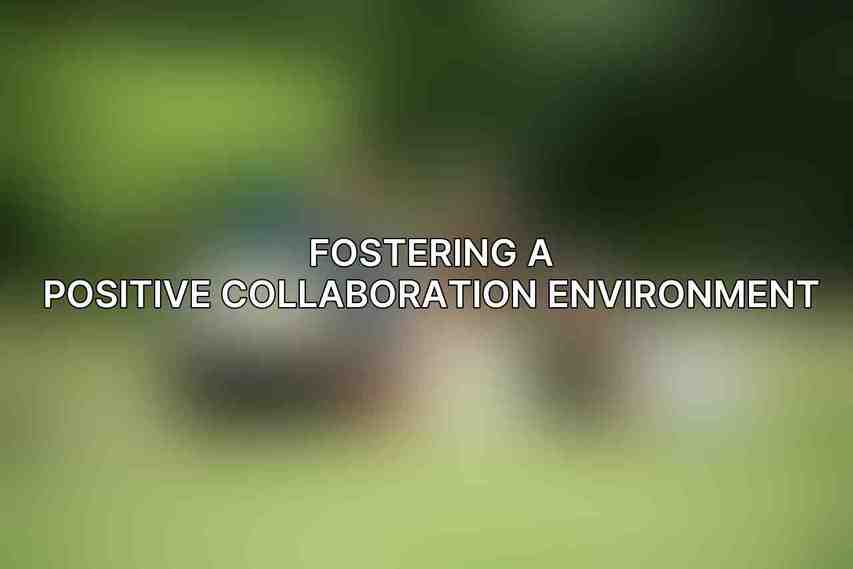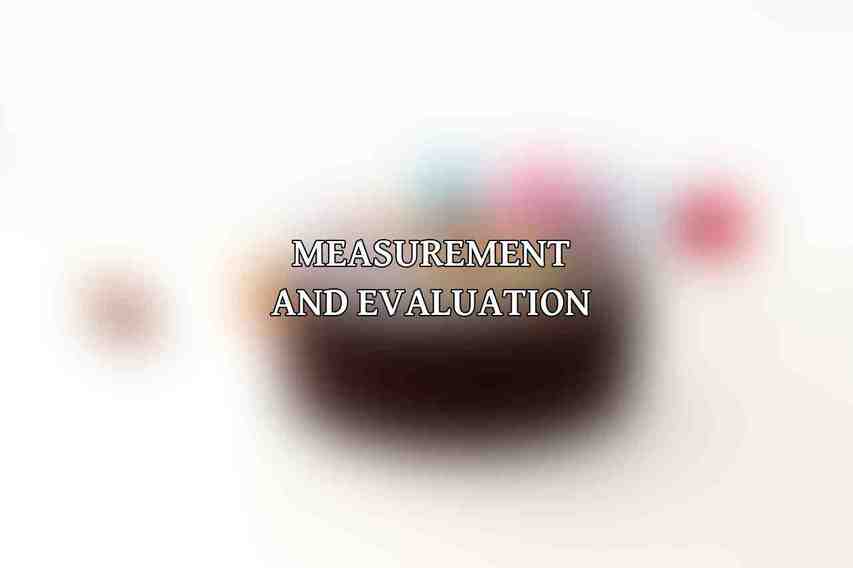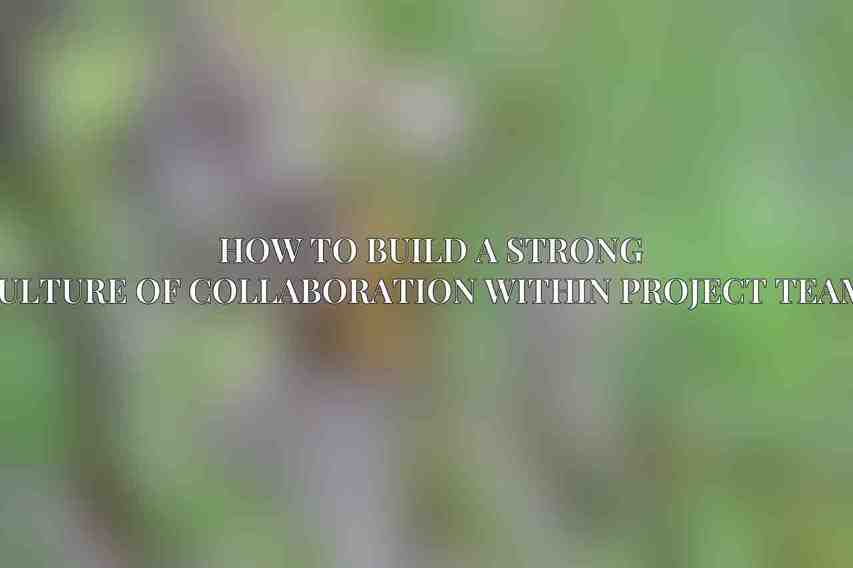Collaboration stands as a fundamental pillar that can significantly impact the success of a project. collaboration refers to the act of working together to achieve a common goal, pooling diverse skills and perspectives to drive innovation and efficiency within project teams. The benefits of collaboration within project teams are immense, ranging from increased productivity and creativity to enhanced problem-solving and decision-making capabilities. It is the cohesive force that binds individuals with unique expertise towards a shared vision, leading to successful project outcomes.
Fostering a collaborative culture within project teams is of paramount importance in this dynamic work environment. A collaborative culture nurtures trust among team members, promotes a sense of ownership and accountability, and cultivates a supportive atmosphere where individuals feel empowered to contribute their best work. By emphasizing collaboration, organizations can harness the collective intelligence of their teams, driving overall performance and fostering a positive work environment.
Establishing a Collaborative Framework
Creating a collaborative framework within project teams involves several key strategies that set the stage for effective teamwork and communication.
A. Set clear goals and expectations
Clear and well-defined goals serve as a roadmap for team members, aligning their efforts towards a common purpose. When objectives are transparent and measurable, team members can better understand their roles and responsibilities, fostering unity and collaboration towards achieving project milestones.
B. Establish open communication channels
Open and transparent communication is the lifeblood of collaboration within project teams. By creating channels for effective communication, such as team meetings, project management software, and instant messaging platforms, team members can share updates, feedback, and ideas seamlessly, ensuring alignment and clarity throughout the project lifecycle.
C. Promote transparency and information sharing
Transparency breeds trust within project teams, enabling team members to feel comfortable sharing their thoughts, concerns, and progress openly. By promoting a culture of information sharing, organizations can break down silos, enhance cross-functional collaboration, and foster a sense of unity among team members working towards a common goal.
D. Implement project management tools to facilitate collaboration
Utilizing project management tools can streamline collaboration efforts by providing a centralized platform for task allocation, progress tracking, and document sharing. Tools such as Asana, Trello, Jira, and Microsoft Project offer features that enhance team collaboration, including real-time updates, task dependencies, and collaborative workspace functionalities.
Fostering a Positive Collaboration Environment

Creating a positive collaboration environment goes beyond the structures and processes; it involves nurturing a culture that values diversity, inclusivity, open dialogue, and mutual respect.
A. Encourage diversity and inclusivity
Diverse teams bring a wealth of perspectives, experiences, and ideas to the table, enriching the collaborative process and fostering innovation. By embracing diversity and inclusivity, organizations can create a vibrant and dynamic team environment where every voice is valued and respected, leading to more robust solutions and outcomes.
B. Create a safe space for open dialogue
Open dialogue is essential for healthy collaboration within project teams. By fostering a safe space where team members feel comfortable expressing their opinions, sharing feedback, and raising concerns, organizations can promote open communication, trust, and psychological safety within the team.
C. Recognize and reward collaboration efforts
Acknowledging and rewarding collaboration efforts can reinforce desired behaviors and motivate team members to actively engage in teamwork. By recognizing individuals and teams for their collaborative contributions, organizations can cultivate a culture of appreciation, teamwork, and shared success.
Managing Challenges to Collaboration
Despite the best intentions, challenges to collaboration may arise within project teams. Effectively addressing these challenges is crucial to maintaining a cohesive and productive team environment.
A. Address conflicts and misunderstandings promptly
Conflicts and misunderstandings are inevitable in any collaborative setting. Addressing these issues promptly and constructively is key to preventing escalation and restoring harmony within the team. Encouraging open dialogue, active listening, and empathy can help resolve conflicts and foster stronger relationships among team members.
B. Manage expectations and workload effectively
Managing expectations and workload is essential to preventing burnout and ensuring team members can collaborate effectively. Clear communication about project timelines, deliverables, and responsibilities can help set realistic expectations and prevent misunderstandings that may impede collaboration.
C. Provide training and support for team members
Equipping team members with the necessary training and support can enhance their collaboration skills and capabilities. Investing in professional development opportunities, mentorship programs, and team-building exercises can strengthen team dynamics, improve communication, and foster a collaborative mindset among team members.
Role of Technology in Enhancing Collaboration
Technology plays a pivotal role in enhancing collaboration within project teams, providing tools and platforms that facilitate seamless communication, task management, and virtual collaboration.
A. Project management tools
Project management tools such as Asana, Trello, Jira, and Microsoft Project offer a range of features designed to streamline collaboration within teams. From task management and progress tracking to file sharing and communication tools, these platforms provide a centralized hub for project coordination and teamwork.
| Project Management Tool | Features |
|---|---|
| Asana | Task management, team collaboration, project tracking |
| Trello | Visual project organization, task assignments, checklists |
| Jira | Issue tracking, agile project management, customizable workflows |
| Microsoft Project | Gantt charts, resource management, project planning tools |
B. Video conferencing tools
Video conferencing tools like Zoom, Microsoft Teams, and Google Meet have become essential for remote collaboration, enabling teams to connect virtually and engage in face-to-face interactions regardless of geographical distance.
| Video Conferencing Tool | Benefits |
|---|---|
| Zoom | High-quality video and audio, screen sharing, breakout rooms |
| Microsoft Teams | Chat, video calls, file sharing, collaboration tools |
| Google Meet | Secure video conferences, live captioning, integration with Google Workspace |
Measurement and Evaluation

Measuring and evaluating collaboration within project teams is crucial to understanding its impact on project outcomes and identifying areas for improvement.
A. Track collaboration metrics
Tracking collaboration metrics such as communication frequency, participation rate in team activities, and knowledge sharing can provide valuable insights into the effectiveness of collaboration strategies within the team. By measuring key performance indicators related to collaboration, organizations can gauge team dynamics and project progress.
B. Conduct regular team evaluations
Regular team evaluations allow organizations to gather feedback from team members, assess collaboration practices, and identify areas for enhancement. By soliciting input from team members through surveys, performance reviews, and retrospective meetings, organizations can continuously refine their collaborative processes and foster a culture of continuous improvement.
building a strong culture of collaboration within project teams is essential for driving innovation, enhancing productivity, and achieving successful project outcomes. By establishing a collaborative framework, fostering a positive collaboration environment, managing challenges effectively, leveraging technology, and measuring collaboration efforts, organizations can create a dynamic and cohesive team environment that thrives on teamwork and synergy. Embracing collaboration not only benefits project performance but also nurtures a culture of respect, learning, and shared success within the organization. It is imperative for organizations to prioritize collaboration as a foundational principle in project management, recognizing its transformative power in shaping high-performing teams and driving organizational success.
Organizations can build a culture of collaboration that propels their project teams towards excellence and innovation. collaboration is not merely a strategy but a mindset that fuels creativity, strengthens relationships, and fosters a sense of purpose among team members. As Henry Ford aptly said, “Coming together is a beginning; keeping together is progress; working together is success.” Let collaboration be the cornerstone of your project teams’ success.
Frequently Asked Questions
1. What is the key to building a strong culture of collaboration within project teams?
The key to building a strong culture of collaboration within project teams is creating an environment of open communication, trust, and mutual respect among team members.
2. How can leaders promote collaboration within their project teams?
Leaders can promote collaboration within their project teams by setting clear goals, fostering a sense of teamwork, and providing opportunities for team members to share ideas and work together towards a common objective.
3. What are some common barriers to collaboration within project teams?
Some common barriers to collaboration within project teams include lack of communication, conflicting goals, and resistance to change. It’s important for teams to address these barriers openly and work towards finding solutions.
4. How can project teams overcome conflicts and disagreements to maintain a collaborative culture?
Project teams can overcome conflicts and disagreements by encouraging open dialogue, active listening, and a willingness to compromise. It’s important for team members to focus on the common goal and work together to find solutions that satisfy everyone.
5. How can team members contribute to building a culture of collaboration within their project teams?
Team members can contribute to building a culture of collaboration within their project teams by actively participating in team meetings, sharing their insights and skills, and supporting their colleagues. By working together towards a common goal, team members can create a supportive and collaborative environment that leads to project success.

